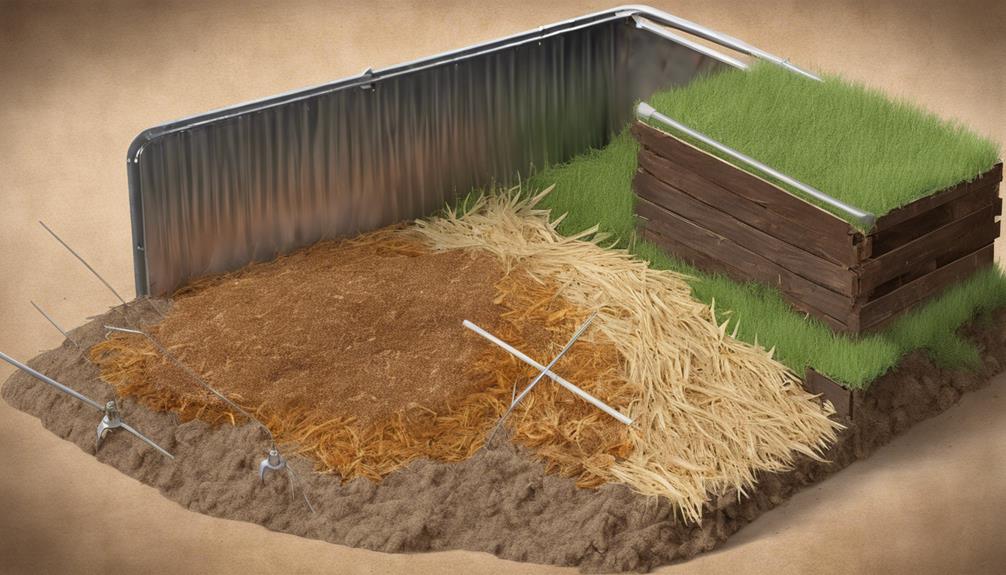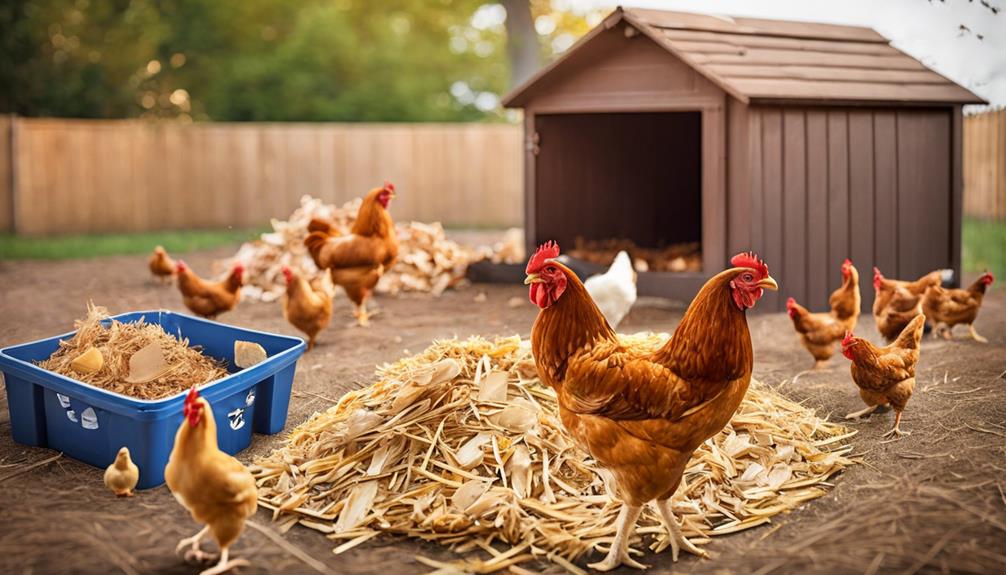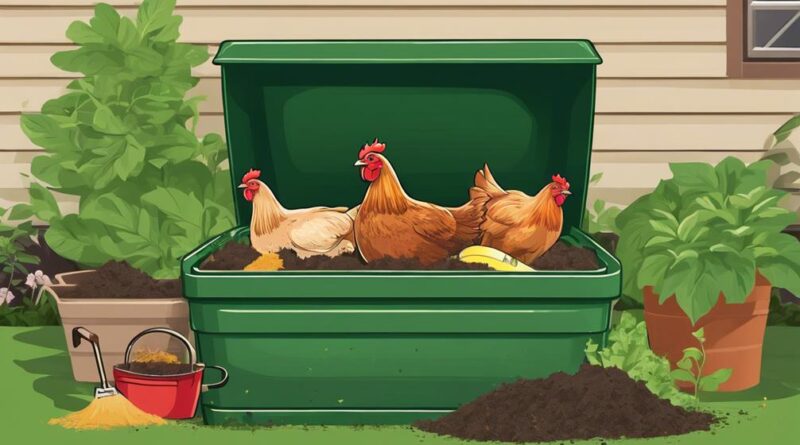10 Best Solutions for Composting Chicken Waste
When composting chicken waste, use aerobic composting or vermicomposting to manage high nitrogen levels effectively. These methods create nutrient-rich compost for sustainable agriculture. Consider space, frequency of waste, and methods for establishing your system. Monitor temperature, nitrogen-carbon balance, moisture levels, and turn the pile regularly. Use carbon-rich materials like straw to balance the waste and maintain moisture levels. Ensure proper aeration to control odors and contamination. By utilizing chicken manure in compost, you enrich soil, promote healthy roots, and enhance fertility. Create a balanced environment that benefits from compost tea and vermicompost for optimal plant growth.
Choosing the Right Composting Method
When composting chicken waste, selecting the appropriate method is crucial for efficient decomposition and nutrient retention. Composting techniques play a vital role in waste management, ensuring that the process is effective and environmentally friendly. There are various methods available, each with its unique benefits and considerations.
One of the most common composting techniques for chicken waste is aerobic composting. This method involves turning the waste regularly to introduce oxygen, which accelerates decomposition. Aerobic composting is efficient in breaking down organic materials and produces nutrient-rich compost that can be used to improve soil quality. However, it requires proper monitoring of moisture levels and aeration to prevent odors and ensure optimal conditions for microbial activity.
Another option is vermicomposting, which involves using earthworms to decompose organic matter. This method is particularly effective for chicken waste due to the high nitrogen content. Vermicomposting not only helps in waste management but also produces a valuable byproduct called vermicast, which is a nutrient-rich organic fertilizer.
Choosing the right composting method depends on factors such as available space, time commitment, and desired end product. By understanding the different composting techniques and their requirements, you can effectively manage chicken waste while producing nutrient-dense compost for your garden or farm.
Establishing a Proper Composting System
To establish a proper composting system for chicken waste, consider the space available, the frequency of waste generation, and the desired composting method. Proper temperature control is crucial for successful composting. The optimal temperature range for composting chicken waste is between 135-160°F (57-71°C). Ensure that the compost pile reaches and maintains these temperatures for effective decomposition and pathogen reduction.
Maintaining a nutrient balance is essential for the composting process. Chicken waste is rich in nitrogen, so it's crucial to balance it with carbon-rich materials to achieve a carbon-to-nitrogen ratio of around 25-30:1. This balance ensures that the composting process proceeds efficiently and prevents the formation of ammonia, which can be harmful to plants and the environment.
Regular monitoring of the compost pile is necessary to ensure that the temperature stays within the optimal range and that the nutrient balance is maintained. Turning the pile regularly, at least once a week, helps aerate the compost and distribute heat and nutrients evenly. Additionally, monitoring the moisture levels is vital to ensure that the compost remains moist but not waterlogged.
Incorporating Carbon-rich Materials
Incorporate carbon-rich materials such as straw or dried leaves into your compost pile to achieve the necessary balance for effective decomposition of chicken waste. Carbon sources are crucial in composting to balance the nitrogen-rich chicken waste. A good rule of thumb is to maintain a carbon to nitrogen ratio of around 25-30 parts carbon to 1 part nitrogen. This balance ensures that the composting process runs smoothly and efficiently.
When adding carbon-rich materials to your compost pile, consider shredding or cutting them into smaller pieces. This increases the surface area available for microbes to break down the materials. It also helps in aerating the compost pile, which is essential for the decomposition process.
Straw is an excellent carbon source commonly used in composting chicken waste. It's dry, easy to handle, and provides good aeration within the pile. Dried leaves are another great option, offering a natural source of carbon that helps maintain airflow and moisture levels in the compost.
Remember to layer the carbon-rich materials with the chicken waste to create a balanced compost pile. Maintaining the right compost ratios is key to successful decomposition. By incorporating carbon sources effectively, you can ensure that your composting system efficiently transforms chicken waste into nutrient-rich compost for your garden.
Maintaining Optimal Moisture Levels
Maintain optimal moisture levels in your compost pile to support the decomposition process effectively. Proper moisture management is crucial for the success of the composting process. The ideal moisture content for a compost pile is around 50-60%. Inadequate moisture can slow down waste decomposition, while excess moisture can lead to unpleasant odors and the growth of anaerobic bacteria, compromising compost health.
To monitor moisture levels, squeeze a handful of the compost material. It should feel like a damp sponge, releasing a few drops of water when squeezed. If it's too wet, add dry materials like straw or sawdust. Conversely, if it's too dry, sprinkle water while turning the pile.
Maintaining optimal moisture levels ensures that microorganisms responsible for breaking down organic matter thrive. These microorganisms require water to carry out their metabolic processes efficiently. By managing moisture effectively, you create a hospitable environment for these beneficial organisms, accelerating waste decomposition.
Turning and Aerating the Compost Pile
Ensure the efficient decomposition of chicken waste in your compost pile by regularly turning and aerating the materials to promote oxygen flow and microbial activity. Turning the compost pile is crucial to introduce oxygen and evenly distribute moisture and nutrients. The frequency of turning depends on the size of the pile and the materials used. As a general guideline, aim to turn the pile every 3-7 days for optimal decomposition.
When turning the compost, use a pitchfork or a compost turning tool to mix the outer layers with the inner core effectively. This process helps aerate the pile and prevents compacting, which can limit airflow. Additionally, consider incorporating aeration techniques such as adding coarse materials like straw or wood chips to improve airflow within the pile.
Proper placement of the compost bin is essential for efficient aeration. Choose a location with good drainage to prevent waterlogging, which can impede airflow and lead to anaerobic conditions. Furthermore, control the temperature of the compost pile by monitoring it regularly. The internal temperature of the pile should ideally range between 135-160°F (57-71°C) to promote the activity of thermophilic microorganisms responsible for breaking down the waste. Adjust the aeration and turning frequency based on the temperature to maintain optimal decomposition conditions.
Monitoring Temperature and Ph Levels
To optimize the composting process for chicken waste, regularly monitor the temperature and pH levels of the compost pile. Maintaining the right conditions is crucial for compost quality and compost health.
- Temperature Control: Keep the compost pile between 135-160°F (57-71°C) for efficient decomposition. Temperatures outside this range can slow down the process and affect compost quality.
- pH Monitoring: Aim for a pH level between 6.0 and 8.0. This range promotes the growth of beneficial microorganisms while inhibiting harmful pathogens, ensuring compost health.
- Regular Testing: Use a compost thermometer to check the temperature daily. For pH levels, conduct tests weekly to make adjustments if needed.
Avoiding Contamination and Odor Issues

When managing your chicken waste compost pile, it's imperative to implement strategies that prevent contamination and control odors efficiently. Odor control is crucial to ensure your composting process isn't disruptive to you and your surroundings. One effective method for odor control is to regularly turn the compost pile. Turning the pile helps aerate it, allowing oxygen to penetrate and facilitate the decomposition process. This, in turn, can significantly reduce the production of foul-smelling gases.
Contamination prevention is equally important when composting chicken waste. To avoid contamination, make sure to separate any non-compostable materials from the chicken manure. Items such as plastic, metal, or chemicals can't only hinder the composting process but also introduce harmful substances into the compost that may affect soil quality. Additionally, maintaining the right moisture levels in the compost pile is essential to prevent contamination by pathogens. The ideal moisture content for a compost pile is around 50-60%.
Utilizing a proper carbon to nitrogen ratio in your compost pile can also aid in both odor control and contamination prevention. The recommended ratio is about 30 parts carbon to 1 part nitrogen. By following these strategies for odor control and contamination prevention, you can ensure that your chicken waste composting process is efficient and environmentally friendly.
Utilizing Chicken Manure in Compost
Utilize chicken manure effectively by incorporating it into your compost mix to enhance nutrient levels and improve soil fertility. Chicken manure is a valuable resource that can significantly benefit your gardening efforts. Here are three key points to consider when utilizing chicken manure in compost:
- Soil Enrichment: Chicken manure is rich in essential nutrients such as nitrogen, phosphorus, and potassium, making it an excellent choice for enriching the soil. These nutrients are crucial for plant growth and development, promoting healthy root systems and vibrant foliage.
- Garden Fertilizer: When integrated into compost, chicken manure acts as a natural fertilizer, releasing nutrients slowly over time. This gradual nutrient release ensures that your plants receive a consistent supply of essential elements, reducing the risk of nutrient leaching and promoting sustainable plant growth.
- Sustainable Agriculture: Incorporating chicken manure into your compost aligns with the principles of sustainable agriculture and organic farming. By recycling this waste product into a valuable resource, you not only reduce environmental pollution but also minimize the need for synthetic fertilizers, fostering a more eco-friendly and sustainable gardening practice.
Composting Chicken Bedding Materials

Enhancing compost quality with chicken bedding materials contributes to nutrient-rich soil for optimal plant growth. Bedding management plays a crucial role in the composting process, as it affects nutrient retention and overall compost quality. Choosing the right bedding materials is essential for maintaining a balanced carbon-to-nitrogen ratio in the compost pile.
When managing chicken bedding for composting, it's important to consider materials such as straw, wood shavings, or dried leaves. These materials not only provide carbon for the composting process but also help absorb moisture and odors, creating a well-aerated environment for beneficial microorganisms to thrive.
Proper bedding management involves regularly mixing the bedding materials to ensure proper aeration and moisture levels. Turning the compost pile regularly helps prevent the formation of anaerobic pockets that can slow down the decomposition process. Additionally, monitoring the temperature of the compost pile can indicate whether the bedding materials are breaking down effectively.
Nutrient retention is key when composting chicken bedding materials. By effectively managing the carbon-to-nitrogen ratio and ensuring proper aeration, the compost pile can retain essential nutrients that are beneficial for plant growth. High-quality compost rich in nutrients can improve soil structure, increase water retention, and promote healthier plant growth in your garden.
Harvesting and Using Compost Effectively
What're the most effective methods for maximizing the benefits of harvested compost in your gardening practices?
Harvesting and using compost effectively can significantly enhance the health and productivity of your garden. To make the most out of your compost, consider the following strategies:
- Using Compost Tea: Compost tea is a powerful liquid fertilizer made by steeping compost in water. It's rich in beneficial microorganisms and nutrients, providing a potent boost to plant growth and soil health. Regularly applying compost tea to your garden can improve nutrient absorption, disease resistance, and overall plant vitality.
- Implementing Vermicomposting: Vermicomposting involves using worms to break down organic matter into nutrient-rich vermicompost. Introducing composting worms into your compost pile can accelerate the decomposition process and result in higher quality compost. The vermicompost produced is teeming with beneficial microbes and plant-available nutrients, making it a valuable amendment for your garden soil.
- Balancing Carbon and Nitrogen Ratios: Properly balancing the carbon-rich and nitrogen-rich materials in your compost pile is crucial for producing high-quality compost. Monitoring and adjusting the C:N ratio ensures efficient decomposition and the creation of compost with optimal nutrient content. A balanced compost pile not only decomposes faster but also yields compost that's rich in essential nutrients for your plants.
Frequently Asked Questions
Can Chicken Waste Be Composted With Other Livestock Manure?
Yes, you can compost chicken waste with other livestock manure to enhance nutrient content and microbial diversity. This combination can boost the composting process, improving decomposition rates and producing a richer soil amendment.
However, challenges such as odor can arise when composting poultry waste. To tackle this, proper aeration, moisture control, and layering with carbon-rich materials like straw or sawdust can help mitigate odors and optimize the composting process.
How Long Does It Take for Chicken Waste to Compost?
When composting chicken waste, the timeline for decomposition varies based on factors like temperature, moisture, and aeration. Typically, it takes around 3 to 6 months for chicken manure to fully compost.
This process yields high-quality compost rich in nutrients that benefit soil health and plant growth. Monitoring the composting timeline ensures proper breakdown of materials and the production of beneficial organic matter for use in gardening or farming.
Is It Safe to Use Compost From Chicken Waste in Vegetable Gardens?
Using compost from chicken waste in vegetable gardens is safe if done correctly. It can enhance soil fertility and nutrient levels, promoting healthy plant growth.
However, ensure proper composting to eliminate pathogens. Consider organic certification and food safety guidelines.
Conduct regular soil testing to monitor nutrient levels and adjust compost application as needed.
What Are the Risks of Pathogens in Chicken Waste Compost?
Pathogen control is crucial when dealing with chicken waste compost to ensure compost safety. High temperatures during composting can help kill harmful pathogens.
Regularly turning the compost pile will aid in even heat distribution. Testing the final compost for pathogens before use in vegetable gardens is also recommended.
Can Composting Chicken Waste Attract Pests Like Rats and Flies?
When composting chicken waste, preventing pests is crucial.
Adequate ventilation and proper composting techniques can help mitigate the risk of attracting rats and flies.
Ensure the compost is well-aerated and turned regularly to discourage pests.
Implementing measures for odor control can also deter unwanted insects and rodents.
Conclusion
In conclusion, implementing the right composting method, maintaining proper moisture levels, incorporating carbon-rich materials, and effectively utilizing chicken waste can result in high-quality compost for your garden.
By following these 10 best solutions for composting chicken waste, you can't only reduce waste but also improve soil health and plant growth.
Remember to regularly turn and aerate the compost pile, avoid contamination and odor issues, and harvest the compost for optimal results.
Happy composting!
